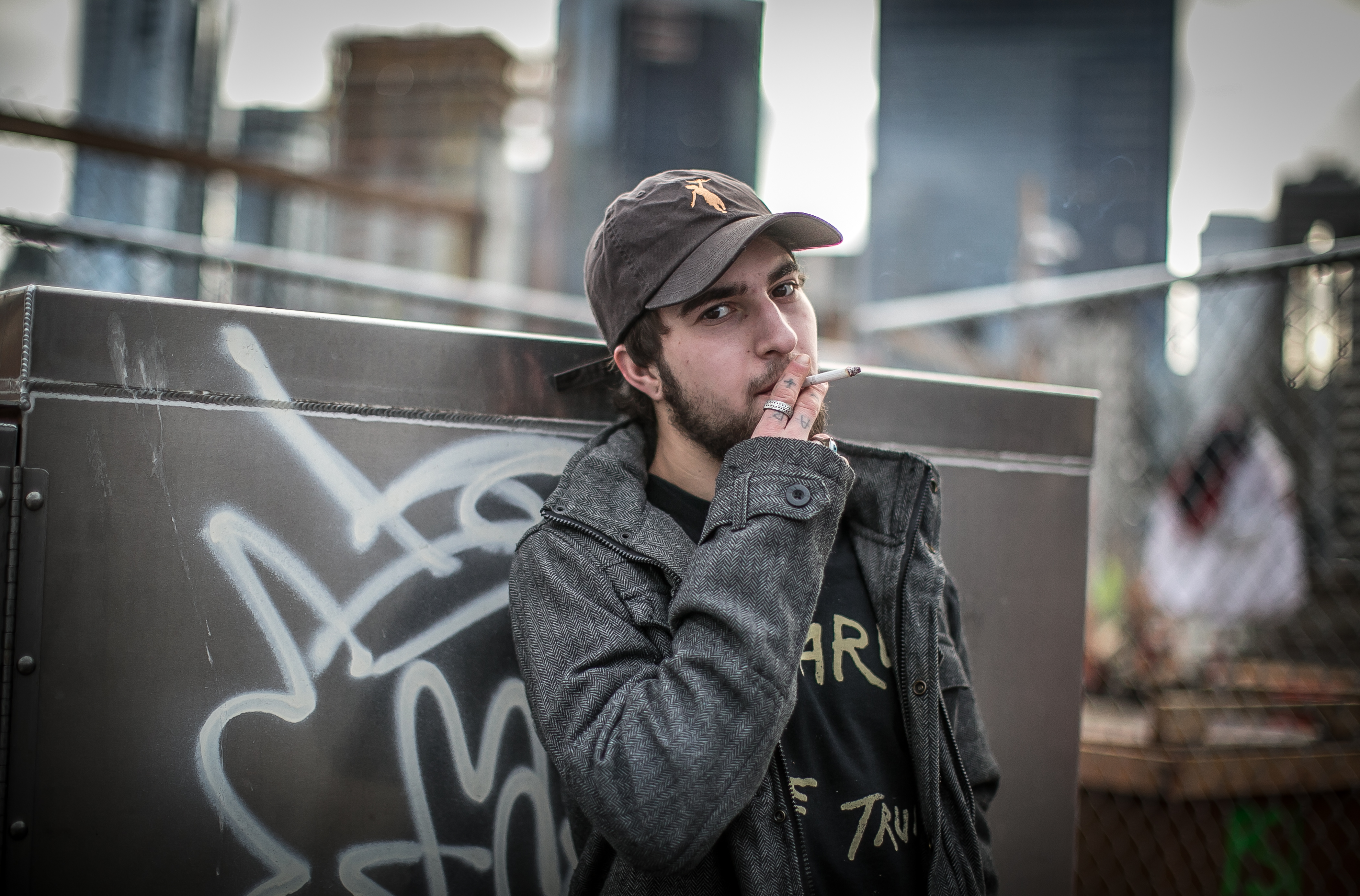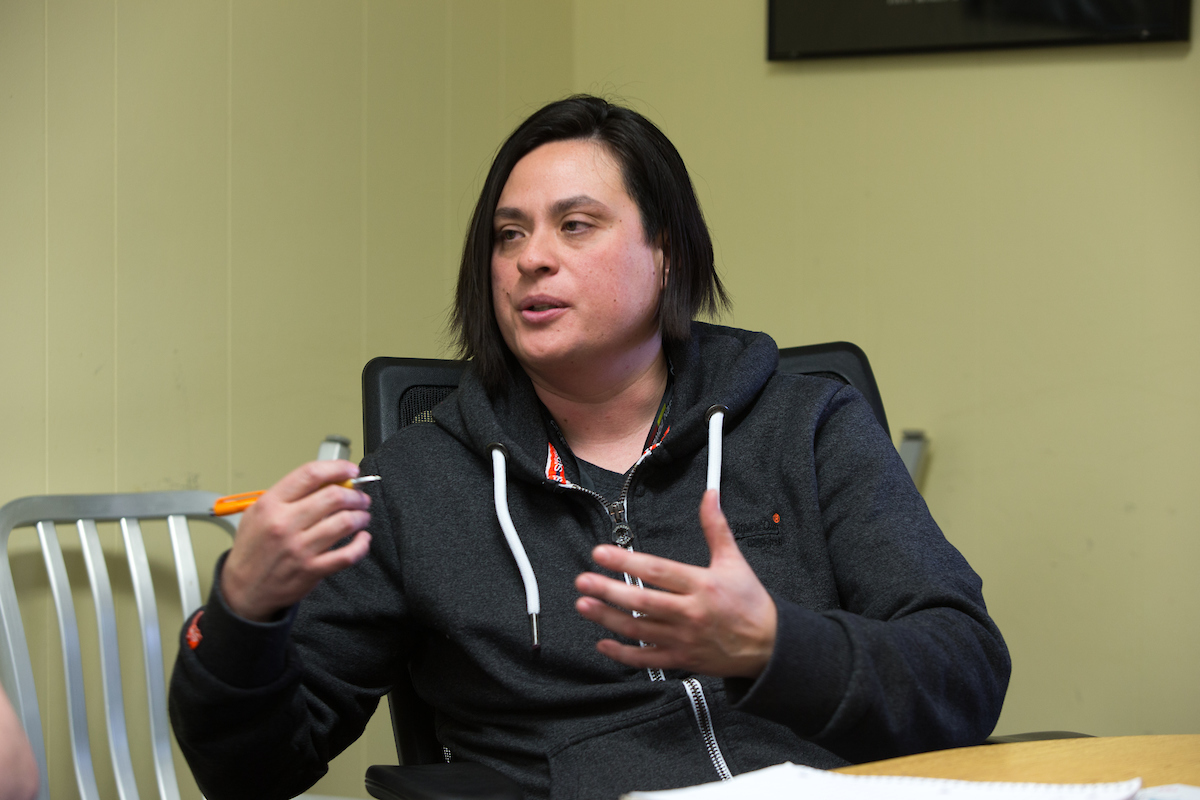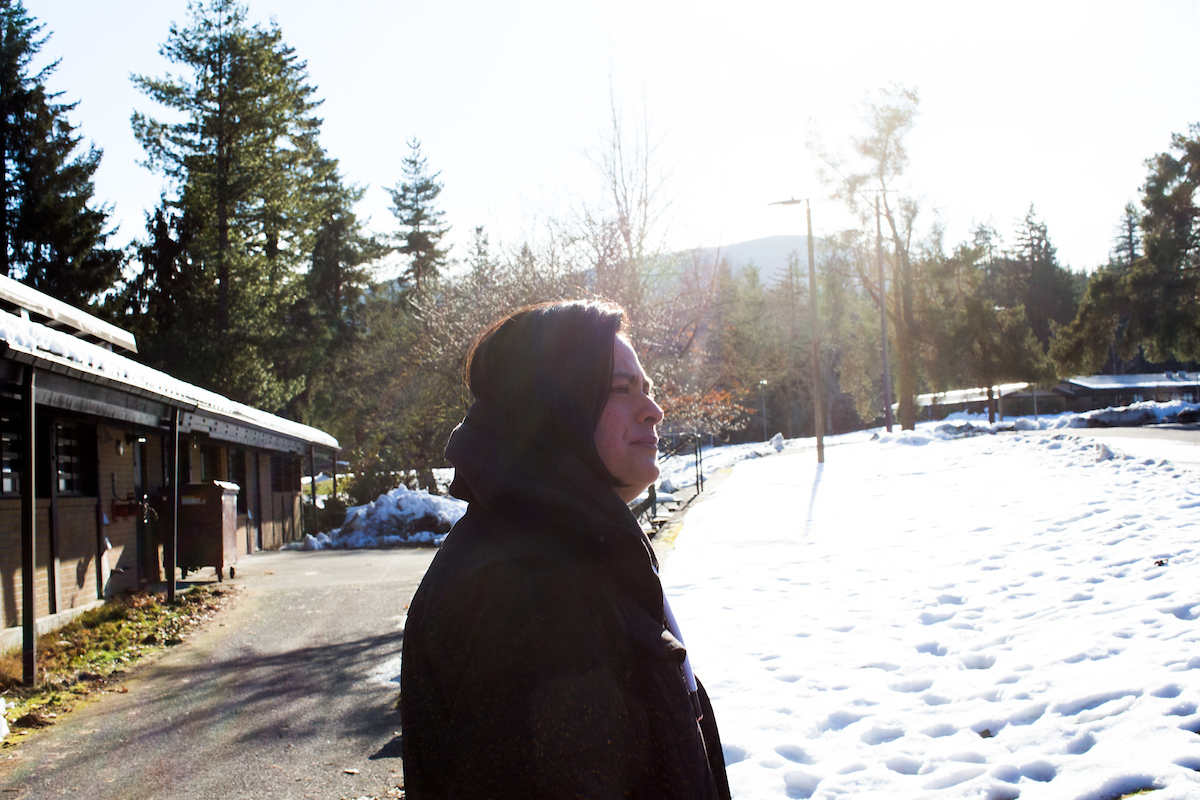
Paul Joseph Brown
David Vanwetter skateboards in Seattle during a recent period of housing instability. Vanwetter, now 21, cycled between detention and homelessness throughout his teens. He recently settled into a new apartment after several weeks of upheaval.
Listen to the interview of reporter Allegra Abramo on KIRO radio 97.3 FM in the program “The Candy, Mike And Todd Show.”
SEATTLE — By the age of 17, David Vanwetter had been in and out of detention perhaps a dozen times.
Often homeless when he went in, he would be right back on the streets when he got out.
It was a cycle of homelessness to detention, detention to homelessness, that the teen had been on since age 13.
As a child on Whidbey Island, 34 miles north of Seattle, he’d pinballed between his divorced parents and a family friend. Amid the chaos and conflict, he took to the streets, where he had to grow up in a hurry.
By the time he was ready for high school, Vanwetter says, he was handling guns, smoking methamphetamine and getting locked up regularly. Out on probation, he would be caught homeless in other cities, then hauled back to detention for “failing to check in,” among other violations.
“I’d get out of juvie and I’d already know, well, I’m going to be back to juvie soon,” said Vanwetter, now 21. “But what I didn’t know was how to not be homeless.”
Washington state is vowing to keep young people like Vanwetter — often with complicated and troubled lives — from becoming homeless after they exit the jailhouse door. The state Legislature has ambitiously pledged to stop releasing youth from “publicly funded systems of care” — juvenile detention, foster care and mental health and drug treatment — into homelessness by the end of 2020. And that doesn’t mean putting them in a cab to a homeless shelter: Youth must have “safe and stable housing,” the law says.
At least 1,800 young people were homeless or unstably housed within a year of exiting those systems, according to the most recent state data available.
No other state has made such a sweeping commitment, according to experts, and Washington does not yet know how it will achieve it. But the state has an interest in ensuring today’s homeless youth don’t become the next generation of homeless adults, and officials are exploring solutions.
Currently, about a quarter of the youth leaving state Juvenile Rehabilitation facilities — the juvenile equivalent of prison, for youth serving sentences of a month or more — are homeless or unstably housed within a year.
In counties across the state, detention administrators often face the dilemma of what to do with kids whose parents can’t be found or refuse to pick them up. In Pierce County alone, 55 miles south of Seattle, that was the case for nearly one-quarter of all detention admissions in 2016. (King County, where Seattle is located, and many others do not track these numbers.) State law requires juvenile jails to release minors to a parent, an approved adult or Child Protective Services.
But what happens after they walk out the door hasn’t been detention’s responsibility. Until now.
‘High-risk kids’
Today, youth often exit detention to a life that makes both future incarceration and homelessness likely.
Many return to families with a history of conflict and trauma, said Eric Trupin, professor of psychiatry and behavioral sciences at the University of Washington. Locking kids up widens those fissures, which puts them “at a high risk for not having a viable place to live and becoming homeless,” he said.
Black and brown kids are most likely to get trapped in both the justice system and homelessness, Trupin added. Just 4 percent of Washington state children are black, yet they make up 22 percent of youth up to age 21 in state juvenile facilities.
Once homeless, young people are at higher risk for mental illness, sexual assault, teen pregnancy and dropping out, as well as committing “survival crimes” such as stealing and selling sex.
Youth homelessness is an expensive problem. It costs an estimated $14,315 per youth to get them permanently housed and off state rolls, according to state Department of Commerce data. It also sets them up for chronic homelessness. Nearly half of homeless adults in King County first experienced homelessness as children or young adults, according to the 2018 point-in-time count.
To meet the legislature’s ambitious goal for 2020, the state Office of Homeless Youth held brainstorming sessions last fall. One major theme was the need for more and varied housing for homeless youth — including dormitory-style group living and rental vouchers — along with more mental health treatment and other support.
State agencies are now working to estimate the costs of the proposals, which they will present to the legislature by the end of this year, leaving just one year for the state to hit its target of zero discharges to homelessness.
“It’s one thing to set a goal,” said Eric Wright, a medical sociologist at Georgia State University in Atlanta who has studied homeless youth. “But don’t create another unfunded mandate,” he cautioned.
These young people, he said, are very challenging to engage and require intensive, specialized programs that go well beyond housing. “I suspect it will take a significant infusion of resources,” he said.

Paul Joseph Brown
“I’d get out of juvie and I’d already know, well, I’m going to be back to juvie soon,” said David Vanwetter. “But what I didn’t know was how to not be homeless.”
Whose job is this anyway?
The state’s 33 juvenile courts, which oversee county detention centers, historically have viewed youth housing problems as beyond their purview.
Megan Frazier, Vanwetter’s parole officer when he was 17, said she knew he was homeless for the year she supervised him. Yet there wasn’t much she could do for him except refer him to the few shelters in the region that accept minors (Whidbey doesn’t have one).
She also called Child Protective Services (CPS) with concerns that he was being neglected but is uncertain what came of that. “I can make reports to CPS, but I can’t make anyone follow through,” she said. Vanwetter said he’s never been in foster care.
CPS has rarely taken custody of homeless adolescents, triaging its resources for younger, more vulnerable children amid a shortage of foster homes, according to lawyers and advocates for homeless youth. Those concerns were a factor in the legislature creating a new child welfare agency last year.
That leaves courts in a difficult spot, although Frazier said her court always releases minors from detention to a responsible adult, following the law. “We have never released anyone, to my knowledge, to the street, if they are under 18 years old,” said Frazier, now the administrator of the Island County Superior and Juvenile courts. (Island County encompasses Whidbey Island.)
In Vanwetter’s case, the responsible adults were sometimes case managers from the local homeless youth drop-in center, although they didn’t have overnight shelter beds. So he spent many days napping on the sofa at the center and nights roaming the streets.
Until recently, Brooke Powell, administrator for Snohomish County Juvenile Court, northeast of Seattle, says she took a similar view that preventing homelessness was other agencies’ concern.
Then last year, she said she had an “aha moment”: About 360 kids a year who come through her court’s doors are homeless or at risk of it, according to an analysis by justice system researchers at the SAJE Center, a collaboration among Washington universities and the Washington State Center for Court Research.
“It struck me very profoundly how many kids that we would actually be able to help if we recognized their housing instability,” Powell said. While her court can’t place a kid in housing, she said, it can connect them and their families with help.
Snohomish, along with Kitsap County, west of Seattle, worked with SAJE on a plan to better screen young people. They will look, for example, for a history of running away or family conflict. Nationally, at least half of young people become homeless after parents kick them out.
Once flagged, youth will work with a housing coordinator, who will connect them and their family with housing and other resources. Snohomish and Kitsap counties expect to hire housing navigators this year. King County Juvenile Court, in partnership with the nonprofit YouthCare, already hosts a housing navigator and is now working with SAJE to expand and evaluate that effort.
If courts focus on kids at risk of getting kicked out or running away, said Sarah Cusworth Walker, a research associate professor at the University of Washington Department of Psychiatry and SAJE co-director, “then you might be able to take a big cut out of down-the-road housing instability.”
Courts outside Washington state also are coming to that conclusion. The National Council of Juvenile and Family Court Judges has urged its member judges to make addressing homelessness part of their job. Some jurisdictions around the country have begun focusing on housing as part of planning for the release of youth, but the success of these efforts remains to be seen.
Recent changes to federal law also could push states in that direction. The 2018 reauthorization of the Juvenile Justice and Delinquency Prevention Act requires states to develop written reentry plans that spell out living arrangements and to report where youth go upon release.

Karen Ducey
Christina Valera, a program specialist with the Washington state office of Juvenile Rehabilitation, speaks with a teenager to help him plan his transition back to society after release from the criminal justice system.
‘We’ve got work to do’
For a preview of the challenges county juvenile courts face in ending the detention-to-homelessness pipeline, they can look to Washington state’s juvenile corrections system. Last year the state office of Juvenile Rehabilitation, which oversees about 1,100 youth, began tackling the problem.
On a late January afternoon, Christina Valera, one of two staff members assigned to that work, had her third meeting with a 19-year-old at Green Hill School. It’s one of the state’s three secure lock-ups for juvenile offenders, in Thurston County, about an hour and a half south of Seattle. The teen had just 40 days left until his release for a sex offense. He is not being named.
In the empty visitation room, Valera sat across from the young man, who had black, rectangular glasses resting on full cheeks. “What are your thoughts about releasing?” she asked.
“I’m thinking about getting released homeless,” he told her, tapping the heels of his sparkling white sneakers. His mom had kicked him out, he said. Going back wasn’t an option.
A local transitional housing program for young adults had a seven-month waitlist. Would he be willing to consider options in a neighboring county?
No, he told her. Leaving “would make my depression worse,” he said.
At least 85 percent of young people in Juvenile Rehabilitation facilities have a mental health or substance use disorder, or both, according to the department.
Valera probed gently, but he wouldn’t budge. He wanted to rent an apartment, he said, but he had only $220 saved.
“If I can’t find a place in Thurston,” he told her, “I’ll be homeless in Thurston County.”
He also needed help finishing high school, picking up belongings from his mother’s house and setting up counseling.
“We’ve got a lot of work,” Valera said, smiling.
After the young man left to finish watching an action movie, Valera worried aloud that “shelters are going to be where he ends up” and that an emergency shelter for homeless adults would be a risky place for him. “You don’t want them to set foot in a homelessness situation at all.”
There are few housing options for young people and even fewer for kids with criminal records, she said. Landlords are reluctant to rent to young adults with a felony record, and many shelters also don’t allow anyone convicted of a violent crime. Other youth are barred from going home by protection orders.
Kids with sex offenses are the toughest to house. They make up more than half of Valera’s caseload.
Back on the road, she stopped next at a Motel 6 in Thurston County. She had helped a mother and her 17-year-old son, who is on parole for a sex offense, get a room there after their landlord had threatened to evict them if the boy moved back in.
Before Valera had intervened, the youth’s only option had been a homeless shelter for adults in Olympia, Wash., a dicey situation for a teen with autism.

Karen Ducey
A new Washington state fund is helping, Christina Valera said, but “Juvenile Rehabilitation is not going to end homelessness by itself.”
Valera had found a housing program for ex-offenders in another county, but he couldn’t move there until he turned 18 in a few weeks. In the meantime, Juvenile Rehabilitation paid for the motel from a new $220,000 state fund for the agency’s homelessness work, which can cover housing costs up to about $2,500 per youth.
That money is a great first step, Valera said, but “Juvenile Rehabilitation is not going to end homelessness by itself.”
Tripling the number of housing specialists like Valera to six is likely to be one of next year’s recommendations to the legislature, at an additional cost of about $424,000 a year, according to the department. Lawmakers this session failed to advance a bill that would have expanded rental vouchers for youth exiting detention, and they still have to figure out how to open more housing to youth with criminal records.
“These are kiddos who have served their time,” Valera said. “And they’re kids, you know. We as a society need to help … get them back on track.”
This article, written in partnership with The Seattle Times, is part of a series by Youth Today on homelessness and its intersection with youth justice. It is made possible in part by support from the Park, Raikes and Tow foundations. Youth Today and The Seattle Times maintain editorial control.





























